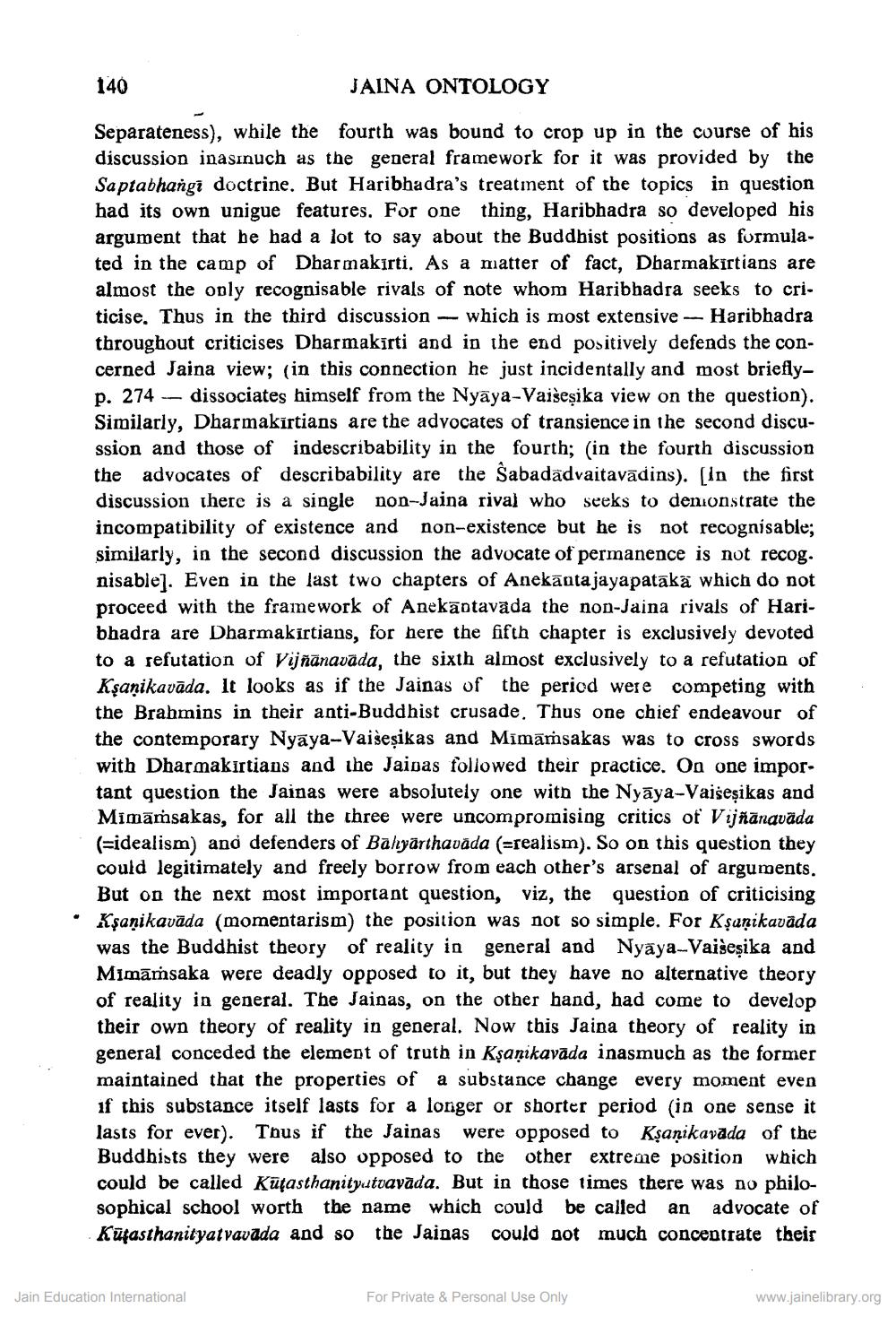________________
140
JAINA ONTOLOGY
Separateness), while the fourth was bound to crop up in the course of his discussion inasınuch as the general framework for it was provided by the Saptabhangi doctrine. But Haribhadra's treatment of the topics in question had its own unigue features. For one thing, Haribhadra so developed his argument that he had a lot to say about the Buddhist positions as formulated in the camp of Dharmakirti. As a matter of fact, Dharmakirtians are almost the oply recognisable rivals of note whom Haribhadra seeks to cri. ticise. Thus in the third discussion - which is most extensive - Haribhadra throughout criticises Dharmakīrti and in the end positively defends the concerned Jaina view; (in this connection he just incidentally and most brieflyp. 274 — dissociates himself from the Nyāya-Vaišeșika view on the question). Similarly, Dharmakīrtians are the advocates of transience in the second discussion and those of indescribability in the fourth; (in the fourth discussion the advocates of describability are the Sabadadvaitavādins). [in the first discussion there is a single non-Jaina rival who seeks to demonstrate the incompatibility of existence and non-existence but he is not recognisable; similarly, in the second discussion the advocate of permanence is not recog. nisable). Even in the last two chapters of Anekāatajayapatākä which do not proceed with the framework of Anekāotavada the non-Jaina rivals of Haribhadra are Dharmakīrtians, for here the fifth chapter is exclusively devoted to a refutation of Vijñānavada, the sixth almost exclusively to a refutation of Kșanikavāda. It looks as if the Jainas of the period were competing with the Brahmins in their anti-Buddhist crusade. Thus one chief endeavour of the contemporary Nyāya-Vaišeșikas and Mīmāmsakas was to cross swords with Dharmakirtians and the Jaipas followed their practice. On one important question the Jainas were absolutely one with the Nyāya-Vaišeşikas and Mimāmsakas, for all the three were uncompromising critics of Vijñānavada (=idealism) and defenders of Bahyarthavāda (=realism). So on this question they could legitimately and freely borrow from each other's arsenal of arguments. But on the next most important question, viz, the question of criticising Kşanikavāda (momentarism) the position was not so simple. For Kșunikavāda was the Buddhist theory of reality in general and Nyāya-Vaiseșika and Mimāṁsaka were deadly opposed to it, but they have no alternative theory of reality in general. The Jainas, on the other hand, had come to develop their own theory of reality in general. Now this Jaina theory of reality in general conceded the element of truth in Kşanikavāda inasmuch as the former maintained that the properties of a substance change every moment even if this substance itself lasts for a longer or shorter period in one sense it lasts for ever). Thus if the Jainas were opposed to Kșanikavada of the Buddhists they were also opposed to the other extreme position which could be called Kütasthanityutuavāda. But in those times there was no philosophical school worth the name which could be called an advocate of Kutasthanityatvavada and so the Jainas could not much concentrate their
Jain Education International
For Private & Personal Use Only
www.jainelibrary.org




